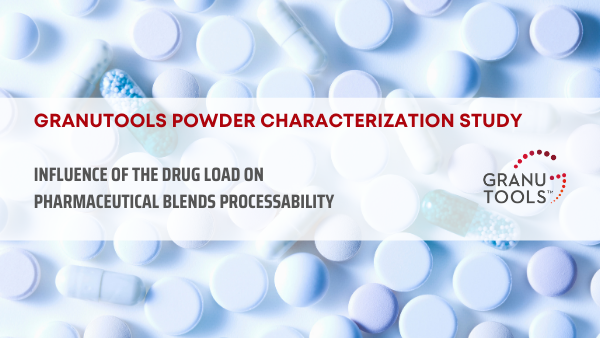Members Login

Channels
Special Offers & Promotions
GranuTools powder characterization study on the Influence of the drug load on pharmaceutical blends processability.

In this study, GranuTools investigate the influence of the drug load on the packing properties and flowability of pharmaceutical powders.
It is well known that flow properties of powders are governed by the intrinsic grain properties and forces acting on and between the grains. It is no surprise that the amount of API present in a blend impacts powder processability.
To this end, GranuTools has developed, over the past years, a whole range of state-of-the-art equipments to allow characterizing the flow properties of powders and granular materials in many different geometries to match process conditions.
In this study, we propose to investigate the influence of the drug load on the packing properties and flowability of pharmaceutical powders. Blends of Acetaminophen (APAP) and silicified microcrystalline cellulose (Prosolv SMCC90) have been produced at different drug loads of APAP. First, the influence of the fraction of APAP on the packing dynamics and flowability of the blends is investigated with the GranuPack. Then, tablets are produced in a rotary press (Natoli® NP-RD30) to evaluate the effect of modification of the powder behavior on the mechanical properties of the tablets. We will show how a proper characterization of the powders can help to gather essential information to predict their performance in the tableting device.

With the GranuPack, bulk density evolution is measured after each tap allowing to investigate the dynamics of packing. The slope index, a measure of the packing kinematics, is presented in the figure below. Interestingly, we observe that the packing is faster for higher drug load despite the decrease of flowability predicted from the Hausner ratio analysis. An increase of cohesiveness due to stronger cohesive interactions should reduce grains mobility and thus a slowdown of packing dynamics is expected. However, the slope index analysis indicates an opposite behavior. The higher cohesiveness of blends with high drug load allows the powder to sustain a looser packing at rest giving room to quickly increase the bulk density after only a few taps. Moreover, the differences in particle sizes between the drug and the excipient could lead to an increasing amount of finer particles to the blend with increasing drug load helping to rapidly fill the void between the larger grains during packing.
Are you curious to see the link between the tablet proprieties and the results showed above? The full application note is available for free along with many other application notes. Visit our website and see how the GranuPack and the other Granutools equipment can bring scientific solutions to industrial problems
Media Partners


